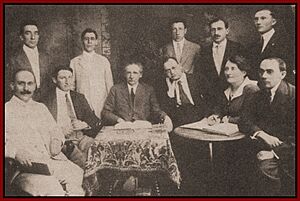Jewish Socialist Federation facts for kids
The Jewish Socialist Federation (JSF) was a group for Jewish people who spoke Yiddish. It started in 1912. This organization was part of the Socialist Party of America (SPA). Many of its first members had been part of a group called the Bund in Eastern Europe. They wanted to bring the ideas of the Bund to the socialist movement in the USA.
In 1921, the JSF split up. This happened because of disagreements about the Bolshevik Revolution in Russia. The JSF left the Socialist Party. A smaller group formed a new organization called the Jewish Socialist Verband (JSV). This new group stayed with the Socialist Party. The main JSF then joined the Workers Party of America, which was linked to the Communist Party USA.
Contents
History of the Jewish Socialist Federation
Why did the Jewish Labor Movement Start?
Experts believe the Jewish labor movement in the United States began in the 1880s. This was due to several important events.
In 1881, Tsar Alexander II of Russia was killed. This led to a wave of violence against Jewish people. These attacks were called pogroms. During these attacks, people were killed, Jewish buildings were destroyed, and property was ruined. The worst of these attacks happened in 1881 and 1882. They took place across the southern and western parts of the Russian Empire. This was where Jewish people were allowed to live.
Many Jewish people decided to leave Russia because of this violence. They moved to the United States. The number of Jewish immigrants grew a lot. In the 1870s, fewer than 35,000 Jewish people came to the US. But in the 1880s, over 175,000 arrived. This wave of immigration continued to increase in the 1890s. During those years, more than one out of every ten new arrivals in the United States was Jewish.
Early Jewish Socialist Groups
Before the JSF, early Jewish socialist groups in the United States focused on events happening abroad. They were like branches of the General Jewish Labor Bund. This was a revolutionary group in Eastern Europe. It aimed to overthrow the ruler of Russia, the Tsar.
The first American branch of the Bund started in 1900. Within five years, about 50 such branches were formed in the US. They were all connected under a group called the Central Union of Bund Organizations. These American Bund groups did more than just send money to the Russian revolutionary movement. They also wanted Jewish people to have their own culture and political power. They did not want to simply blend into American society.
From 1905, many local Yiddish-speaking groups were loosely connected. This was done by a group called the Jewish Socialist Agitation Bureau. A tailor from Rochester, New York named Max Kaufman founded it. Kaufman wanted his Bureau to bring well-known Yiddish-speaking socialists from New York City. These speakers would then talk to Jewish communities in cities like Rochester, Buffalo, and Syracuse. This idea worked well. Famous socialists like economist Isaac Hourwich and politician Meyer London went on speaking tours. The Bureau also helped share leaflets and pamphlets written in Yiddish.
The Socialist Agitation Bureau held a meeting every year. The existing network of Bundist clubs helped the organization grow. By 1909, it was thought that 80 to 90 percent of the Bureau's groups had ties to the Bund.
How the JSF Was Formed
In the early 1900s, many workers in American cities were immigrants. The Socialist Party of America wanted to connect better with workers who did not speak English. To do this, they expanded their "language federations." These were groups that worked together. They helped organize party branches that spoke the same language. They also made it easier to share pamphlets and leaflets in that language.
The Finnish Socialist Federation was formed in 1906 when many Finnish-speaking socialist clubs joined together. But the Jewish Socialist Federation was created mostly by the Socialist Party itself. Yiddish-speaking Socialist Party branches already existed. They were regular parts of the state and national Socialist Party. They paid their dues like other branches. The only difference was the language they used for their meetings.
As early as 1907, Max Kaufman, who founded the Jewish Socialist Agitation Bureau, suggested creating a Yiddish language federation within the Socialist Party. But this idea was first rejected by some Jewish socialists. They saw it as giving in to "ethnic nationalism" instead of focusing on international unity among workers. One important Jewish socialist said that "in America special Russian Jewish wounds do not exist." He believed there was no need for special Jewish groups in America.
However, the idea of organizing Yiddish-speaking Socialist branches continued to grow. In the summer of 1910, a big step was taken. The Socialist Party's rules were changed. Any non-English language group with 500 or more members could become a federation. They would have a paid official called a "Translator-Secretary" at the party's main office in Chicago. Over the next two years, the Socialist Party started federations for its Czech, Hungarian, Italian, Polish, Swedish/Norwegian, and Slovenian members. In 1912, the Yiddish-speaking Jewish Socialist Federation was formed.
Not all Jewish people in the Socialist Party joined the Jewish Socialist Federation. Many were part of English-speaking branches instead. Some even disagreed with the Jewish Federation. They preferred that Jewish immigrants become more "Americanized" and join American political life. They saw the federation approach, which focused on ethnicity, as moving away from the socialist idea of international unity. Activist and historian Will Herberg described the JSF as "virtually a Jewish Socialist Party within the...Party."
Growth of the Federation
The Jewish Socialist Federation grew very quickly. Soon, it had about 65 local branches. Its membership reached almost 3,000 people. Even though it was organized around ethnicity rather than social class, the Jewish Federation attracted some of the most radical Jewish socialists. It soon became more left-leaning than the Socialist Party itself.


